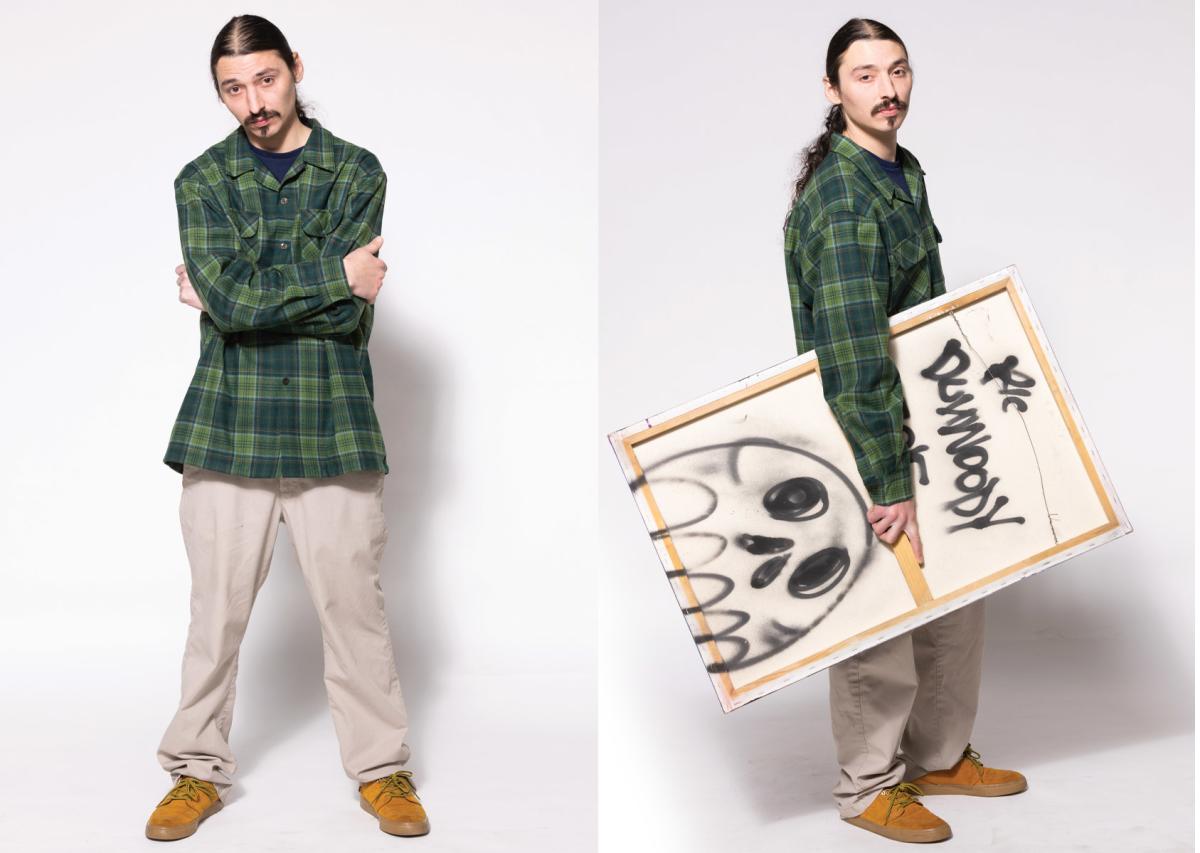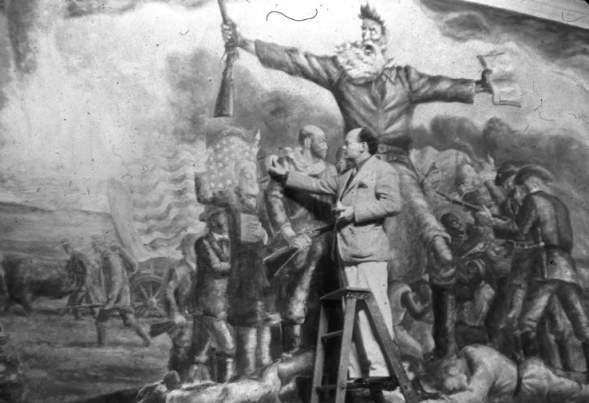 Photography by Jason Dailey (Mona Cliff) and Aaron Patton (Ric Dunwoody)
Photography by Jason Dailey (Mona Cliff) and Aaron Patton (Ric Dunwoody)
Ric Dunwoody and Mona Cliff talk contemporary Native art and the futures they envision
“When it comes to Native artwork, to me, I’m Native, so anything I do is Native artwork, whatever it is,” says Ric Dunwoody (Pâri/Pawnee, Jiwere/Otoe, and Waⁿdát/Wyandotte), a visual artist from Wichita. Native artists like Dunwoody continue to redefine the boundaries—if any—on what it means to be a Native artist and what they create.

For Lawrence artist Mona Cliff (Aaniiih/Gros Ventre Tribe of Montana), that journey is tied to the ingenuity of ancestors who have continually adapted to new mediums and made them their own. Beadwork and ribbonwork are great examples. “The women in our communities, and in all different tribes along the Plains and just everywhere, they really took those materials and ran with them and took them to new places that they weren’t even intended for,” Cliff says. That same drive exists within her. “How far can I push this whole bead thing? That’s the work that I’m doing now. I’m working on a 7-foot piece, using seed beads, and how far can I push this material?” says Cliff.
Dunwoody also finds inspiration from the past and includes visual references in his work. “That’s just another nod to past heritage … especially with it being expression and artwork, it’s just kind of like a slight homage to how we were using artwork to tell stories … to share with other people,” he says. “What I appreciate about making artwork is that it gives me an opportunity to make people step outside themselves and look at other cultures,” he says. “I do play on that quite a bit in my artwork.”
For Cliff, the dialogue with Native heritage is represented through projects such as her Past/Presence/Future series. “I started visualizing that future and where we’re kind of heading now when it comes to just the steps we’re taking as humanity and how we’re relating to the earth that we live on and what is going to be the consequences of that,” she says. One of the pieces, a beaded gas mask, serves as a symbol for passing cultural knowledge on to the next generation. “How do we still retain teachings? We’ve already gone through that transformation as a Native people. We’ve already been through it. We are kind of living right now in a dystopian future from our ancestors’ perspective and this huge shift in who we are as a people. We’ve managed to hang on to a lot of teachings and reshuffle [them], like reimagine, by taking the things that they used for trade and then reapplying that and making something even more beautiful…”
One challenge contemporary Native artists face is the public perception of Native Americans only as historic peoples. “Gatekeeping Indian identity is really important [to talk about], and it’s a conversation I actually have a lot with people who are Native,” Dunwoody says. Contemporary Native art moves beyond what Dunwoody calls “charcoal drawings of Sitting Bull,” and focuses on what it means to be Native today. That often means exploring multiple contexts surrounding Native identity. For Dunwoody, that exploration is an opportunity to share his culture as an “urban Indian.” From 1953 through 1969, dubbed the Termination Era, the US terminated the status over a hundred tribes and used relocation programs to move Native peoples from reservations to cities. The goal was the assimilation of Native Americans and the abolishment of tribal reservations and federal obligations. It has been through the resilience of individuals to retain their culture and the formation of Indian Centers in cities that communities have held together and developed urban Native cultures and identities. Today, nearly two thirds of Native Americans, including Cliff and Dunwoody, live in cities.

The complexity of Indian identity means that there is no one way to be Native and there is no one way to be a Native artist. These artists bring visibility to that diversity. Despite Lawrence being home to Haskell Indian Nations University, Cliff says, “There isn’t a lot of representation in our city that represents Native people, and especially when it comes to art.” Cliff’s recent public mural projects in Lawrence address this need. “I felt that with that public art project I wanted to uplift Native people and culture and make art that reflected the vibrancy of our culture and make art for us first,” she says. “That was my goal. I wanted to make art where we saw ourselves in the city, and if that spoke to non-Native people and they wanted to make inquiries about what this art means—or just kind of connect to Native people—that was the goal of my project.”
Ultimately, how people view art is up to them. “Even if someone has seen [my work] and it made them uncomfortable, I like that. If it made them feel a way—in any way, even if it’s a bad way—then you’re still looking at it, and it’s making you think,” Dunwoody says. “I’m real big on leaving it up to interpretation because I’d like each person to look at the art and whatever they take from it, I love that.”
Cliff is currently working as a diversity, equity, and inclusion field representative for Indigenous communities for the Kansas Creative Arts Industry Commission. “Part of my role in that capacity is to try to bring non-Native entities and organizations and connecting them to Native organizations,” she says. According to Cliff, many of the businesses might have one Native organization they go to, but that can eclipse working with a variety of new or diverse Native organizations. The grassroots organizations and small artists also need support because they are the people doing the work in their communities.
Cliff believes part of the hesitancy for people to engage with contemporary Native art is that people may not understand the history behind the work. Tribal websites, local centers, and organizations provide information, opening possibilities for non-Natives to access the context behind Native art. “I really think a lot of non-Native people should take on the responsibility of educating themselves instead of expecting Native people to do the work for them because we already have a lot we are hanging onto. We’ve already got a lot of responsibility on our shoulders and continuing our future and continuing to uplift our own people. We really need support by non-Natives doing the work for themselves and educating their communities,” Cliff says.
“You just have to look for the [artists],” Dunwoody says, “because [they’re] there, and there is a lot of cool and new things happening that just might not have that public venue to be shown. That is where I want for it to go. That anybody creating in this Native atmosphere would get better opportunities to showcase and grow without having to get a big deal from corporations.” Visibility is important. “I’ve had people reach out to me and tell me I was a positive influence on their kids—just seeing me as a Native doing stuff in that Native art world. Those shows a lot of times aren’t huge shows. It’s kind of just a small community situation, so if those kinds of shows were to get a lot more publicity, it could turn into a really big thing. Instead it’s kind of just us doing our own thing in our own lane and our own people showing up. It should be the city that comes and celebrates. That’s where I think it should lead to—a broader audience.”
Artist to Artist
We asked artist Mona Cliff to name three other contemporary Native artists who inform and inspire her own creations. She shared her admiration and thoughts about the work of three artists with the 𐓷𐓘𐓻𐓘𐓻𐓟/Osage nation, the people whose territory covers what is now much of eastern Kansas.
Anita Fields
𐓷𐓘𐓻𐓘𐓻𐓟/Osage textile and visual artist
“What I admire about Anita Fields is how she incorporates Osage culture and mythologies into her work.”
Yatika Starr Fields
𐓷𐓘𐓻𐓘𐓻𐓟/Osage visual artist
“What I enjoy about his art is the energy and dynamic application of paint. His work through the Tulsa art fellowship is inspiring.”
Norman Akers
𐓷𐓘𐓻𐓘𐓻𐓟/Osage visual artist
“His work is inspiring and thoughtful. I am intrigued by the symbolism he uses in his paintings.”
Ways to Stay Connected
More Art Stories You'll Enjoy
View ALlFrom the Archives: Remembering John Steuart Curry
Jan 15, 2024Editor's Note: This article was originally published in the winter of 1992 by Don Lambert… Read More
A Paper Moon Pilgrimage
May 19, 2023Photography by Jessi Jacobs Celebrate 50 years of this classic Hollywood film by following the… Read More
Test Your Lumberjack skills with Axe-Throwing
Mar 30, 2023Photography by David Mayes It’s a family outing, date-night fun, stress-reliever and more… Read More
‘Part of the Legacy that Shapes Who We are’
Mar 24, 2023Photography by Carter Gaskins Oscar-winning filmmaker Kevin Willmott talks about his life in Kansas… Read More
Mid-Century Woodworking
Mar 23, 2023Zack Schaffer exudes midwestern modesty. He ranches by day, running several hundred head of cattle… Read More









